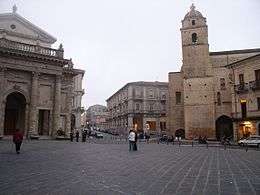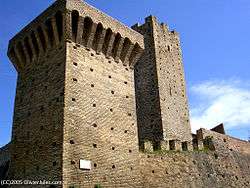Lanciano
| Lanciano | ||
|---|---|---|
| Comune | ||
| Città di Lanciano | ||
|
Historical centre of Lanciano. | ||
| ||
 Lanciano Location of Lanciano in Italy | ||
| Coordinates: 42°14′N 14°23′E / 42.233°N 14.383°E | ||
| Country | Italy | |
| Region | Abruzzo | |
| Province / Metropolitan city | Chieti (CH) | |
| Frazioni |
Camicie, Colle Campitelli, Colle Pizzuto, Costa di Chieti, Follani, Fontanelle, Gaeta, Iconicella, Madonna del Carmine, Marcianese, Nasuti, Re di Coppe, Rizzacorno, Sabbioni, San Iorio, San Nicolino, Santa Croce, Santa Giusta, Santa Liberata, Santa Maria dei Mesi, Sant'Amato, Sant'Egidio, Sant'Onofrio, Serre, Serroni, Spaccarelli, Torre Marino, Torre Sansone, Villa Andreoli, Villa Carminello, Villa Elce, Villa Martelli, Villa Pasquini, Villa Stanazzo | |
| Government | ||
| • Mayor | Mario Pupillo | |
| Area | ||
| • Total | 66 km2 (25 sq mi) | |
| Elevation | 265 m (869 ft) | |
| Population (1 January 2015)[1] | ||
| • Total | 35,624 | |
| • Density | 540/km2 (1,400/sq mi) | |
| Demonym(s) | Lancianesi | |
| Time zone | CET (UTC+1) | |
| • Summer (DST) | CEST (UTC+2) | |
| Postal code | 66034 | |
| Dialing code | 0872 | |
| Patron saint | Madonna del Ponte | |
| Saint day | September 16 | |
| Website | Official website | |
Lanciano is a town and comune in the province of Chieti, part of the Abruzzo region of central Italy. It has 36,304 inhabitants as of 2011.
The city is also known for the first recorded alleged Catholic Eucharistic Miracle.
Geography
The city is located on hills and its town territory covers 66 square kilometres (25 sq mi) from Val di Sangro to Castelfrentano, and its elevation is about 265 metres (869 ft) above sea level.
It is bordered by Atessa, Castel Frentano, Fossacesia, Frisa, Mozzagrogna, Orsogna, Paglieta, Poggiofiorito, Rocca San Giovanni, San Vito Chietino, Sant'Eusanio del Sangro and Treglio.
Regarding the climate, the temperature averages about 4 °C (39 °F) in winter and 25 °C (77 °F) in summer. It usually snows about three times a year. During the summer there can be sultry days.
History


The ancient Roman name of Lanciano was Anxanum, a city of the Frentani Italic tribe. The city is said to have been founded in 1181 BC by Solimus, a Trojan refugee arrived in Italy along with Aeneas. Legends aside, archaeological findings have shown that the area was settled from the 5th millennium BC.
Under the Frentani it was probably under the influence of Greater Greece. After the end of the Samnite Wars, which saw the Frentani allied with the Romans, Lancianum obtained the status of municipium. It was probably a flourishing commercial site, across an ancient and important trade route connecting Pescara to Apulia.

According to tradition, Lanciano is also the birthplace of Longinus the Roman centurion who thrust his spear into Jesus' side during the Crucifixion: Lanciano in Italian means "of the Spear"
During the fall of the Western Roman Empire, Lanciano was sacked by the Goths, and was destroyed during the Lombard invasion (c. 571 AD). A new settlement was then created around a castle built by the new rulers. In 610, however, it was conquered by the Byzantines, who annexed it to the Duchy of Teate (Chieti) and allowed the trades to restart. In the late 8th century Lanciano was conquered by the Franks, who included it in the Duchy of Spoleto.
In 1060 the Normans made it a centre of the unified Kingdom of Sicily. Lanciano flourished again and in 1340 it was the largest city in Abruzzo with 6,500 inhabitants, renowned industries (ceramics, wool, silk, goldworks, ironworks), receiving important privileges by both Frederick II and his son Manfred, with a substantial administrative autonomy. Charles I, King of Sicily, assigned the revenues of the city's port to the Vatican Basilica. Later it was frequently at war with nearby Ortona.
It was here that Pope Gregory XII, fleeing from Cividale, landed on Neapolitan territory (1409), and went thence to Gaeta. After the end of the Italian Wars, the new Spanish rule and the shift of commerce due to the discovery of America impoverished Lanciano, which, in 1640, became a baronial possession.
Later, the city took the part of the Neapolitan Republic of 1799 and rose against the Bourbon kings in 1848, 1849 and 1853. In 1860 it voted for annexation to the newly formed Kingdom of Italy.
During World War II it was an active center of the Resistance against the German occupation. On 6 October 1943 Italian citizens attacked German soldiers (revolt of the martyrs of October 1943). In 1952 it was awarded the Gold Medal to Military Valour by President Luigi Einaudi.
Main sights


- Cathedral of Santa Maria del Ponte ("St. Mary of the Bridge"), so called because it is built on bridgework along a precipice: is the work of Michitelli (1619) and has some paintings by Pozzulaniello (Giacinto Diana). It houses also an 8th-century Byzantine statue portraying the Madonna, probably brought here during the iconoclast controversy.
- Chiesa di Santa Maria Maggiore, one of the most important architectural sites in Abruzzo. Built in 1227 according to Bourgogne-Cistercian lines, it was updated in 1540 in Baroque style, with the addition of two aisles and stucco decorations (recently stripped off). The main gate is from 1317.
- Chiesa di San Francesco (1258), built over a pre-existing 7th-century church. The high altar houses the relics of the Eucharistic Miracle.
- Chiesa di Sant'Agostino (1270). The façade has maintained the original rose window and the gate, while the single nave interior is a Baroque restoration.
- Chiesa di San Biagio (11th century) is the oldest church of the city. It has a bell tower and it's always opened on 3 February for the anointing of the throat, a Catholic rite linked to the cult Saint Biagio.
- Torri Montanare, a relic of the ancient walls (11th century). They consist in two massive towers, the most recent dating to the 15th century, offering a panoramic view of the area.
- Porta San Biagio (11th century), the only one gate remaining of the nine once existing.
- Torre civica (19th century), was built over a pre-existing tower next to the Cathedral. Nowadays it is a belfry and a clock tower.
- Torre Aragonese, (15th century) was a tower along the ancient walls.
- Palazzo dell'Arcivescovado, (16th century) is still the seat of the archbishop and houses a diocesan Museum.
- Botteghe medievali, was a house built in 1434. It has two floors and on the ground floor there are antique shops, with external bank according to the Roman use.
Transport
- Lanciano railway station
- San Vito-Lanciano railway station
Honors
- Gold Medal of Military Valor.

Subdivisions
Apart from the city of Lanciano, the comune (municipality) of the same name contains 33 contrade. The population of the contrade has been estimated (as of 2005) at 12,682.
They are: Camicie, Colle Campitelli, Colle Pizzuto, Costa di Chieti, Follani, Fontanelle, Gaeta, Iconicella, Madonna del Carmine, Marcianese, Nasuti, re di Coppe, Rizzacorno, Sabbioni, San Iorio, Santa Croce, Santa Giusta, Santa Liberata, Santa Maria dei Mesi, Sant'Amato, Santa Nicolina, Sant'Egidio, Sant'Onofrio, Serre, Serroni, Spaccarelli, Torremarino, Torre Sansone, Villa Andreoli, Villa Carminello, Villa Elce, Villa Martelli, Villa Pasquini, Villa Stanazzo.
The Lanciano football team is a serie b club
Education
Canadian College Italy is located in Lanciano.
Famous people
- Camillo Pace (Paglieta, 1862–1948), Protestant pastor.
- Marco Rapino (born 1983), lead programmer, Angry Birds Seasons, and Bad Piggies
- Dario Cataldo (born 1985), professional cyclist and winner of the Queen Stage of the 2012 Vuelta a España
Twinnings
 Berazategui, Argentina
Berazategui, Argentina Qala, Malta, since 2005
Qala, Malta, since 2005 Perho, Finland
Perho, Finland Vaughan, Ontario, Canada, since 2002
Vaughan, Ontario, Canada, since 2002 Visegrád, Hungary, since 2006
Visegrád, Hungary, since 2006
See also
| Wikimedia Commons has media related to Lanciano. |
